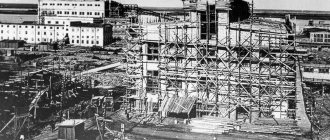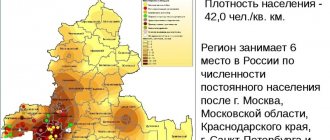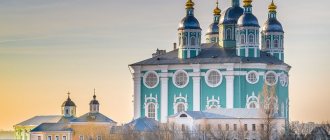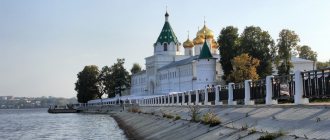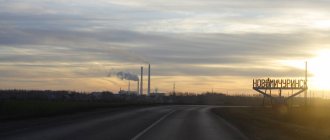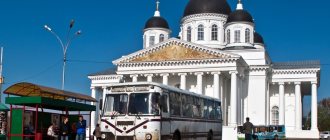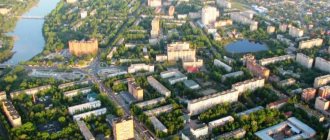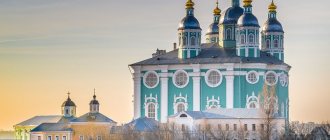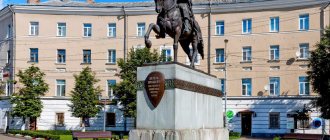Year founded: 1348
Aleksin celebrates the city day on
the 1st Saturday of August
.
In 2022,
this date is
August 6
.
The official founding date of the city is 1348
Aleksin
- a Russian city in the Tula region, located 60 km northwest of Tula, on both banks of the Oka River and on the Kaluga-Tula railway.
This is one of the oldest cities in this region. The official founding date of the city is 1348
, under which it was first mentioned in the Nikon Chronicle (in connection with the destruction of Aleksin by the troops of the Horde prince Temir) as a fortress on the steep left bank of the Oka. According to one version, the city received its name from the name of Metropolitan Alexy of Moscow, since it belonged to the head of the Russian Orthodox Church in 1354-1378.
It is reliably known that in 1472, the residents of Aleksin played an important role in repelling the Tatar attack on the Russian lands of the Khan of the Great Horde, Akhmat. When he approached their wooden fortress with significant forces, the townspeople did not give up and bravely defended themselves. And although the Tatars completely burned the city, these few days, while the defense lasted, were enough for the Russian troops to gather to confront the enemy and defend Moscow. The Oka line turned out to be firmly occupied by Russian regiments, and the khan did not dare to enter the battle and returned to the Horde.
For two centuries, Aleksin remained an important outpost of the defensive system of the Russian lands. Since then, and
for two centuries, Aleksin remained an important outpost of the defensive system of the Russian lands
, not only to repel Tatar raids, but also incursions from the Grand Duchy of Lithuania, and the location of the Grand Duchy "right hand shelf" In 1566, the city was included in the personal possessions of Ivan the Terrible, thus becoming a special sovereign inheritance - the oprichnina. And during the Time of Troubles of the early 17th century, he participated in the rebel movement of Ivan Bolotnikov, going over to the side of False Dmitry I. But already in 1607, Aleksin was taken by the troops of Vasily Shuisky.
Due to the expansion of the borders of the Russian state, by the beginning of the 18th century the city lost its military significance and in 1719, being by that time the administrative center of Aleksinsky district, it became part of the Tula province of the Moscow province. Since 1777, Aleksin has been a county town with a trading pier on the Oka River, serving Tula. In addition, fishing has been very developed here since ancient times.
St. Nicholas Church
In the 18th century, Aleksin gradually turned into a trade and craft city, which was facilitated by its convenient location on the navigable Oka waterway, iron ore deposits in the county, the presence of iron-making factories in the area and the proximity of Tula arms factories, and the needs of the local population for handicraft products. So, in 1728, not far from the city, the Mosolov brothers built the first ironworks). And the famous Aleksin merchant dynasties of the Azimovs, Maslovs, Zolotarevs, Rykalovs, Savostins, Shatskys specialized in the wholesale trade of livestock, grain and timber. In the 19th century, vocational schools, the first public banks, libraries, factories were opened in Aleksin, a railway was built...
In 1937, Aleksina entered the newly formed Tula region. At this time, it became a recognized industrial center of the Tula region - many industrial enterprises (chemical plant, thermal power plant and others) were built in the city at the rapid pace of the first five-year plans.
Mound of Glory with eternal flame
The city is also famous for its military exploits. Residents participated in the militia during the Patriotic War of 1812 and during the Great Patriotic War, when Aleksin played an important strategic role - in this area, Soviet troops held superior enemy forces to prevent a breakthrough on the Moscow-Tula road. And although the Nazis managed to occupy the city - it was occupied on November 29, 1941, but literally a month later it was liberated - on December 17 by troops of the Western Front during the Kaluga operation. During the war years, 7,662 Aleksin residents died a heroic death. Ten people were awarded the title of Hero of the Soviet Union.
In the post-war years, the powerful industrial development of the city continued - the reinforced concrete products plant (KZHI-480), the Aleksinsky meat processing plant and other enterprises were put into operation. New educational institutions have opened. In 1958, Aleksin became a city of regional subordination.
Aleksin-Bor is a unique natural monument
But Aleksin is known not only for industry.
Here, the climate is unique in its healing properties, the beautiful Oka River with its sandy reaches and picturesque banks, relict pine forest, healing mineral springs - all this has brought the city the glory of the pearl of the Tula region
. At the end of the 19th century, these picturesque urban surroundings became a permanent vacation spot for summer residents from Tula, Moscow and other cities of Central Russia. At different times, writers V. Veresaev, A. Chekhov, B. Pasternak vacationed here; artists N. Ulyanov, I. Levitan, V. Vatagin; composers A. Scriabin, R. Shchedrin; scientists I. Sechenov and V. Snegirev; artists V. Pashennaya, N. Smirnova, V. Kachalov and many other figures of national culture and art.
Today Aleksin, which since 2005 has been an independent municipal entity with the status of an urban settlement, is an administrative, industrial and cultural city, one of the most stable and dynamically developing in the Tula region.
Among the attractions of Aleksin the most famous are:
Aleksin-Bor is a relict pine forest, a natural monument of regional significance; the old part of the city - Zarechye, which has largely preserved the features of the Russian province of the last century, architectural monuments of the 17-19 centuries; Sorokinskoye, Petrovskoye and Ilinskoye settlements, which have archaeological value; ensemble of the Assumption Cathedral (19th century), St. Nicholas Church (18th century), Museum of Local Lore and others. Also in the city there is a Victory Memorial with an eternal flame and a mass burial of soldiers who fell during the Great Patriotic War and other memorial places. In general, Aleksin has more than 130 historical and cultural monuments, five of which are of federal significance.
The population of the city is about 57 thousand people (as of 2020).
Hometown Day
Aleksinians celebrate it on the first Saturday of August. Entertainment programs are prepared in all areas of the city, and they are a great success.
Aleksin is in 6th place in terms of population in the Tula region
Tulastat yesterday posted data on the population of the Tula region as of January 1, 2022. The total figure is 1,499,486 people. That is, we were only 515 residents short of remaining on the list of a region with a population of one and a half million people?
If so, that's sad. Although the hope of not losing the status of “one and a half million people” still remains. For the above data, as specifically noted in the summary, is a “preliminary assessment.” The fact is that there is still no accurate information on the balance of external migration to the region. So far, there is data for 11 months, according to which the preponderance of those arriving for permanent residence (permanent residence) in the Tula region over the departing residents is about five thousand. If December turns out to be equally positive, then it is possible that the benefit of compensation for the “missing” half a thousand people will be “clarified”.
However, even if this happens, the information will still be sad. Because in any real “demographic and migration” scenario, by the summer of 2022 the Tula region is almost guaranteed to lose its recent status. And its population will become less than one and a half million people. With the prospect of subsequent reduction and further. This process - under the best circumstances - should end in 2020-2021. Due to positive migration – if it continues – we should formally reach “zero”. But the excess of birth rates over deaths will apparently have to wait until 2025 or even 2028.
By the number of residents of cities, districts, municipalities. Lira, of course, “Big Tula” - 552,071 people. The regional center is so far the only “subject” of the province where the number of residents has grown slightly – by two to three hundred people. Naturally, at the expense of visiting people. The mortality rate in the hero city is also higher than the birth rate, as elsewhere in our country. For information: of this number, approximately 64 thousand people are residents of the Leninsky district. That is, the population directly in the city of Tula is about 488 thousand people. And in reality, the status of “half a million” here was also lost several years ago. In this regard, there is a bad, but, alas, slightly real joke: when the potential of the Leninsky district ends, Tula, in order to maintain the status of a city of “half a million,” will have to annex the Shchekinsky district. Then it will be enough for a long time, and in terms of territory we will become the largest city in Russia after Moscow.
In second place is Novomoskovsk, 137,684 people. Further, in descending order: Shchekinsky (106,102), Uzlovsky (81,725) and Kireyevsky (73,067) districts, the cities of Aleksin (67,770) , Donskoy (63,822) and Efremov (56,931), as well as Bogoroditsky (51,202) and Suvorovsky (34,882 people) districts. The minimum population by district is Kamensky (8,836), Arsenyevsky (9,676), Kurkinsky (9,676), Teplo-Ogarevsky (12,143) and Odoevsky (12,777 people). And the list is completed by two mysterious “micro-municipalities” in their socio-economic essence - the villages of Novogurovsky (3,431) and Slavny (1,887 people).
Well, let’s not forget to mention the smallest city in the country, which is also located in the Tula region. This is the city of Chekalin in the Suvorovsky district, where today less than 1,700 people live. Although, according to Russian laws, city status is assigned to settlements with a population of more than 10 thousand people. But this is an exception. And, by the way, it’s not the only one with us. There is also the city of Sovetsk in the Shchekinsky district, less than 9 thousand people live there, and this number is constantly decreasing...
Transport
A railway line runs through the city, running from Vyazma to Rzhev via Tula. Aleksin is also connected to Tula, the regional center, by a highway that runs from the village of Zhelaznya to the Moscow-Simferopol highway and has bus service to the cities of Moscow, Kaluga, Serpukhov, Tula and a bus service to the cities of Kaluga and Serpukhov. All central estates of agricultural enterprises are connected to the city of Aleksin by paved roads and are provided with bus service.
Content
Industry
Currently, Aleksin is one of the most developed industrial zones in the Tula region.
The largest share falls on chemical production, mechanical engineering and the production of building materials.
The main city-forming enterprises of the city are the chemical plant and (produces shut-off valves for the oil and gas industry).
Leading enterprises: Federal State Unitary Enterprise Aleksinsky Experimental Mechanical (household chemicals and rubber products), LLC Elektrotekhnicheskaya, LLC NovoPlast, LLC Aleksinskaya Clothing Factory, CJSC Cherokee, CJSC Aleksinskaya Paper and Cardboard Factory. There are also food industry enterprises: bread and meat processing plants, a dairy plant.
Content
Fauna
Aleksin and Aleksinsky district are located in the northern and northwestern parts of the Tula region (forest zone) and are inhabited mainly by forest species of animals.
Artiodactyls that live in natural conditions include: wild boar, roe deer, and elk. Elk is the largest animal in the fauna of our country.
The order of predators is represented by the following species: wolf, fox, otter, etc. Predators: light polecat, European mink, badger are rare and protected by law.
The largest predator in the region is the wolf. It is distributed throughout the Tula region, but its numbers are insignificant (10-15 wolves). Weasel is the smallest predator in the region. The otter lives in the reservoirs of the region. Valuable fur-bearing animals are pine marten, fox, and black polecat.
Order of insectivores: hedgehog, mole, shrew, etc. Lagomorphs: brown hare and white hare.
The most numerous order of mammals are rodents: squirrel, gopher, muskrat, mice, etc. A unique order of mammals: chiropterans, or bats, can be seen late at night while walking outside the city.
About 150 species of birds live in the Aleksinsky district. The most common ones are rooks, starlings, swallows, and sparrows. Bullfinches come to us for the winter.
Some species of birds are very rare and are listed in the Red Book of Russia - these are the falcon, hoopoe, kingfisher, eagle and spotted eagle. In general, in the Tula region there are only 16 species of birds.
Quite a few amphibians live in our area: frogs, toads, newts.
Content
Agriculture
Agriculture of the Aleksinsky district has a livestock sector. In the Aleksinsky district there are 3 large livestock complexes (Avangard - for fattening cattle, Privolye - for milk production, Pershino - for breeding heifers).
Local farms grow rye, wheat, oats, buckwheat, potatoes, fodder beets, corn, sunflower for silage, fruit and vegetable crops.
Content
Materials used from the following sites:
- Personal website of Nikolai Kosterev (https://nkosterev.narod.ru/)
- Information and analytical portal of the Tula region (https://71r.ru)
Climate
The climate is temperate continental, characterized by well-defined seasons: moderately warm summers and moderately cold winters.
The average temperature in July is +(18-20°C), in January - (9-10)°C. The warm period (with a positive average daily temperature) lasts 220-225 days. The lowest temperature was observed in January 1940 (Kolosovo) -48.5°C, the highest in July +37°C. The first frosts are observed at the end of September, the last - in early July. The frost-free period is on average 140 days.
Snow cover from mid-November to mid-April, on average 140 days. Maximum height in February-March, 36 cm. Soil freezing depth, up to 1.5 m.
From November to February, winds prevail from the south and south-west. From April to September the wind regime is unstable, with a slight predominance of southern and western directions. The average annual wind speed is 2.9 m/s.
Atmospheric precipitation is distributed evenly throughout the year. The annual precipitation is about 600 mm. Average annual relative humidity is about 78%
Content
Natural monuments
Aleksin-Bor. It is located within the city limits of Aleksin, in its western part on the high right bank of the river. Okie. Organized on the basis of a pine forest that has survived to this day. The area is 398 hectares, with 353 hectares covered by forest.
The source of the blessed old woman Euphrosyne. Located in the village. Klyupanovo not far from the town of Aleksin, on the left steep slope of the ravine at a height of 3 m above the stream bed. It was discovered by Elder Euphrosyne in the 40s. XIX century and since then has been revered by residents of the surrounding areas.
Nearby is the Holy Kazan Convent. In the village of Egnyshevka the spring of St. Panteleimon is known.
Content
Flora
In the Aleksinsky district there are coniferous, mixed and deciduous forests. In coniferous forests there are pine and spruce, and artificially bred larches. But still, the main forest-forming species is pine.
The remnant of the “mountain” forest (pine forests growing on the steep slopes of river valleys in central Russia, where bedrock chalk and calcareous rocks lie close) can be considered a park on the steep left bank of the Oka River in the town of Aleksin (Petrovsky microdistrict). Mighty 35-45 meter pines grow here on calcareous soil, covered with a thin layer of quaternary loam.
Among the large pine forests, Aleksin-Bor is widely known, occupying an area of about 750 hectares. It preserves natural islands of pure pine plantations.
The age of the trees ranges from 70-120 years. The height of some reaches 35 meters. The diameter of the trunks is 80-90 cm.
The layer of shrubs consists of hazel (hazel), euonymus, viburnum, buckthorn, and juniper. In the grass cover of the forest, along with representatives of the northern species (lingonberry, boneberry), it is typical to find representatives of the steppe flora (strawberry, lungwort, hoofweed, lily of the valley, etc.).
In the part adjacent to the city, the forest has no undergrowth, and the grass cover is very scarce due to constant trampling. The trees here have almost stopped growing and bear fruit poorly. A new phenomenon of the last decade is the total littering of forests with non-degradable household waste. Because of this, many trees wither and subsequently die. In recent years, natural regeneration of pine trees in the forest has not occurred.
Aleksin's forest fund (including forest parks and other green spaces, including landscaping of inconvenient areas) occupies an area of 332 hectares, or 8 percent of the total territory of M.O. Aleksin.
Content
Nature
Aleksin lies in a picturesque hilly area and is surrounded by ancient forests.
The subsoil of the Aleksinsky district contains brown coal, marbled limestone, halite, gypsum, refractory clay, construction and quartz sands, gravel, sodium salt and mineral water (2 types), which is used for sanatorium treatment.
The main water artery is the Oka River and its tributaries. In addition to it, 7 small rivers flow through the area, there are more than 70 ponds and many streams and lakes.
Priokskie springs are widely known - coastal sources of slightly mineralized fresh water.
Zhalka Park in the Gorushki microdistrict is rightfully considered the most beautiful park in the city, combining slender pine trees and wonderful decoration.
Aleksinsky district is clean in terms of radiation, because was not exposed to contamination during the accident at the Chernobyl nuclear power plant.
There are state game reserves of regional significance with an area of 15 thousand hectares, and the entire area of hunting grounds is 56 thousand hectares. The ungulates inhabit the area: elk, wild boar and roe deer.
At the Aleksinsky Chemical Plant GPO there is a workshop for the reproduction of valuable sturgeon breeds. The plant annually stocks the river with fish. Okie is a sterlet fry.
A quarter of the region's territory is occupied by broad-leaved and pine forests. Along the right bank of the Oka lies the century-old pine forest of Aleksin-Bor, a natural monument of local importance (approx. 400 hectares in area). The fauna is rich and diverse: about 50 species of mammals, 200 species of birds, and 30 species of fish live in the area. There are hunting grounds (area 54.5 thousand hectares), two reserves: “Bobrovy” (on the Krushma River, area 3 thousand hectares) and “Sotinsky” (area 11.1 thousand hectares).
Content
